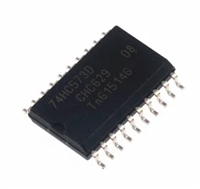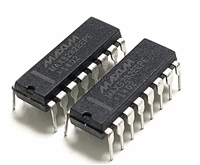ADP1111
350
300
250
200
150
100
50
The ADP1111 provides external connections for both the
collector and emitter of its internal power switch that permit
both step-up and step-down modes of operation. For the step-
up mode, the emitter (Pin SW2) is connected to GND, and the
collector (Pin SW1) drives the inductor. For step-down mode,
the emitter drives the inductor while the collector is connected
to VIN.
BIAS CURRENT
The output voltage of the ADP1111 is set with two external
resistors. Three fixed-voltage models are also available:
ADP1111–3.3 (+3.3 V), ADP1111–5 (+5 V) and ADP1111–12
(+12 V). The fixed-voltage models are identical to the
ADP1111, except that laser-trimmed voltage-setting resistors
are included on the chip. On the fixed-voltage models of the
ADP1111, simply connect the feedback pin (Pin 8) directly to
the output voltage.
0
–40
0
25
TEMPERATURE – ؇C
70
85
Figure 14. Set Pin Bias Current vs. Temperature
COMPONENT SELECTION
General Notes on Inductor Selection
THEORY OF OPERATION
When the ADP1111 internal power switch turns on, current
begins to flow in the inductor. Energy is stored in the inductor
core while the switch is on, and this stored energy is transferred
to the load when the switch turns off. Since both the collector
and the emitter of the switch transistor are accessible on the
ADP1111, the output voltage can be higher, lower, or of
opposite polarity than the input voltage.
The ADP1111 is a flexible, low-power, switch-mode power
supply (SMPS) controller. The regulated output voltage can be
greater than the input voltage (boost or step-up mode) or less
than the input (buck or step-down mode). This device uses a
gated-oscillator technique to provide very high performance
with low quiescent current.
A functional block diagram of the ADP1111 is shown on
the first page of this data sheet. The internal 1.25 V reference is
connected to one input of the comparator, while the other input
is externally connected (via the FB pin) to a feedback network
connected to the regulated output. When the voltage at the FB
pin falls below 1.25 V, the 72 kHz oscillator turns on. A driver
amplifier provides base drive to the internal power switch, and
the switching action raises the output voltage. When the voltage
at the FB pin exceeds 1.25 V, the oscillator is shut off. While
the oscillator is off, the ADP1111 quiescent current is only
300 µA. The comparator includes a small amount of hysteresis,
which ensures loop stability without requiring external compo-
nents for frequency compensation.
To specify an inductor for the ADP1111, the proper values of
inductance, saturation current and dc resistance must be
determined. This process is not difficult, and specific equations
for each circuit configuration are provided in this data sheet. In
general terms, however, the inductance value must be low
enough to store the required amount of energy (when both
input voltage and switch ON time are at a minimum) but high
enough that the inductor will not saturate when both VIN and
switch ON time are at their maximum values. The inductor
must also store enough energy to supply the load, without
saturating. Finally, the dc resistance of the inductor should be
low so that excessive power will not be wasted by heating the
windings. For most ADP1111 applications, an inductor of
15 µH to 100 µH with a saturation current rating of 300 mA to
1 A and dc resistance <0.4 Ω is suitable. Ferrite-core inductors
that meet these specifications are available in small, surface-
mount packages.
The maximum current in the internal power switch can be set
by connecting a resistor between VIN and the ILIM pin. When the
maximum current is exceeded, the switch is turned OFF. The
current limit circuitry has a time delay of about 1 µs. If an
external resistor is not used, connect ILIM to VIN. Further
information on ILIM is included in the “APPLICATIONS”
section of this data sheet.
To minimize Electro-Magnetic Interference (EMI), a toroid or
pot-core type inductor is recommended. Rod-core inductors are
a lower-cost alternative if EMI is not a problem.
The ADP1111 internal oscillator provides 7 µs ON and 7 µs
OFF times that are ideal for applications where the ratio
between VIN and VOUT is roughly a factor of two (such as
converting +3 V to + 5 V). However, wider range conversions
(such as generating +12 V from a +5 V supply) can easily be
accomplished.
CALCULATING THE INDUCTOR VALUE
Selecting the proper inductor value is a simple three step
process:
1. Define the operating parameters: minimum input voltage,
maximum input voltage, output voltage and output current.
An uncommitted gain block on the ADP1111 can be connected
as a low-battery detector. The inverting input of the gain block
is internally connected to the 1.25 V reference. The noninverting
input is available at the SET pin. A resistor divider, connected
between VIN and GND with the junction connected to the SET
pin, causes the AO output to go LOW when the low battery set
point is exceeded. The AO output is an open collector NPN
transistor that can sink 300 µA.
2. Select the appropriate conversion topology (step-up, step-
down, or inverting).
3. Calculate the inductor value using the equations in the
following sections.
REV. 0
–6–






 深入解析AD7606高性能多通道模数转换器:资料手册参数分析
深入解析AD7606高性能多通道模数转换器:资料手册参数分析

 74HC573三态非易失锁存器(Latch)资料手册参数分析
74HC573三态非易失锁存器(Latch)资料手册参数分析

 MAX3232 RS-232电平转换器资料手册参数分析
MAX3232 RS-232电平转换器资料手册参数分析

 MAX485 RS-485/RS-422收发器资料手册参数分析
MAX485 RS-485/RS-422收发器资料手册参数分析
